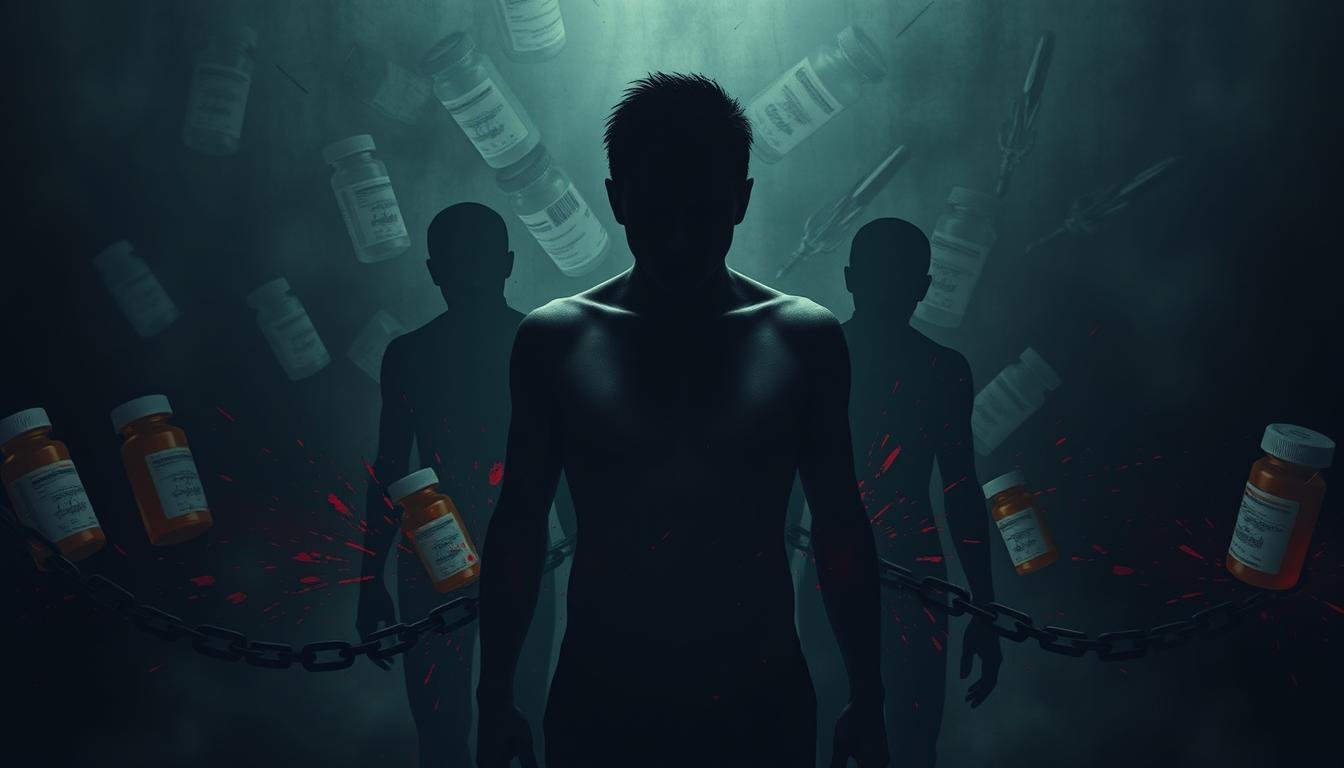Opioid Addictions: The Physical Toll & Health Risks Explained
Have you ever thought about what opioid addiction really does to our bodies? It’s a serious issue that affects many. In 2019, nearly 50,000 people in the U.S. died from opioid overdoses. This shows how dangerous opioids can be.
Using opioids can lead to serious health problems. These include feeling pain more easily and needing higher doses, which increases the risk of overdose. Long-term use can cause chronic constipation and breathing problems during sleep.
Babies born to mothers who used opioids can also face health issues. These babies may have withdrawal symptoms, known as neonatal abstinence syndrome. It’s important to understand these risks to fight the opioid crisis.
Key Takeaways
- Opioid addictions can lead to significant health risks, including increased sensitivity to pain.
- Higher opioid dosages raise the risk of overdose significantly.
- Withdrawal symptoms can be severe and include anxiety, muscle aches, and insomnia.
- Long-term use can result in serious side effects such as chronic constipation and sleep-disordered breathing.
- Neonatal abstinence syndrome affects many babies exposed to opioids in utero.
- Education and awareness are critical in addressing the opioid epidemic.
Understanding Opioid Use Disorder (OUD)
Opioid Use Disorder (OUD) is a serious condition affecting millions. It makes people want to use opioid drugs, even if it harms them. Knowing about OUD helps us tackle opioid addiction better.
What is Opioid Use Disorder?
OUD is a chronic disease marked by dependence on opioids. This includes prescription drugs and illegal ones. Long-term use, often over six months, can lead to dependence.
Physical signs can show up in just a few weeks. People may need more drugs to avoid withdrawal. The DSM-5 calls OUD a chronic illness that needs early treatment.
Opioid Addiction as a Chronic Disease
Opioid addiction is complex, with many causes. Genetics, mental health, and environment play big roles. Research shows genetics can be a big factor, affecting 40% to 60% of people.
Half of those with mental health issues also have substance use disorders. This makes treatment key for recovery. Without it, addiction can ruin lives, causing financial problems and harming relationships.
| Factor | Impact on OUD |
|---|---|
| Genetic Vulnerability | 40% to 60% susceptibility to developing OUD |
| Mental Health Conditions | Approximately 50% of individuals with mental health issues may also have SUD |
| Adverse Childhood Experiences (ACEs) | Significantly increase risk for developing OUD |
| Prescription Opioid Use | 3% to 19% of prescribed users may develop OUD |
| Environmental Influence | Accessibility in regions like North America increases OUD rates |
Signs and Symptoms of Opioid Addiction
It’s important to know the signs of opioid addiction to help someone get treatment. Addiction can show in many ways, like physical dependence or big changes in behavior. Knowing these signs helps me see when someone might need help.
Physical Dependence and Withdrawal Symptoms
Physical dependence is a key sign of opioid addiction. When someone stops using, they might get withdrawal symptoms. These can be mild or very bad and include:
- Anxiety
- Chills and sweating
- Muscle aches and pains
- Nausea and vomiting
- Insomnia
These symptoms can make people want to use opioids again to feel better. This keeps the addiction cycle going.
Cognitive and Emotional Symptoms
Opioid addiction also messes with how someone thinks and feels. People might have strong cravings and think about using opioids a lot. This can lead to:
- Difficulty concentrating
- Increased anxiety about getting drugs
- Feeling depressed or hopeless
These problems can make it hard to keep up with work or personal life. It’s important to deal with these symptoms quickly.
Behavioral Changes Indicating Addiction
Changes in how someone acts can also show opioid addiction. Signs include:
- Staying away from family and friends
- Spending a lot of money on opioids
- Not taking care of personal hygiene or responsibilities
Seeing these changes means someone might be having trouble with drugs. Spotting these signs is key to helping them get better.
| Type of Symptoms | Examples |
|---|---|
| Physical Dependence | Withdrawal symptoms, cravings |
| Cognitive Symptoms | Difficulty concentrating, obsessive thoughts |
| Emotional Symptoms | Anxiety, depression |
| Behavioral Changes | Isolation, financial issues, neglecting responsibilities |
Knowing these signs helps me support those with opioid addiction. It’s all about creating a space where they can get the help they need.
Opioid Addiction Effects on the Body
Opioid addiction has severe effects on the body. It harms various parts of the body and overall health. Knowing these effects helps us understand the dangers of long-term opioid use.
Physical Toll of Opioid Abuse
Opioid abuse affects the body in many ways. Some common problems include:
- Respiratory Depression: Opioids can slow breathing, which is dangerous, even in overdose situations.
- Cardiovascular Problems: Opioids can harm the heart, leading to irregular beats or disease.
- Gastrointestinal Issues: Opioids often cause constipation and can lead to long-term digestive problems.
- Weight Loss: Users may lose a lot of weight because they don’t feel hungry.
- Cognitive Decline: Long-term use can cause memory problems and lower cognitive function.
Long-Term Health Implications
Opioid addiction leads to serious health problems over time. Users face:
- Increased Risk of Infections: Opioids weaken the immune system, making users more susceptible to illnesses.
- Organ Damage: Long-term use can cause permanent damage to organs like the liver and kidneys.
- Decreased Libido: Users often see a big drop in sexual function and desire.
Learning about the effects of opioid abuse and addiction health issues is critical. It highlights the need for effective prevention and treatment. Knowing these facts can help people make better choices and seek help for themselves or others.
| Health Impact | Details |
|---|---|
| Respiratory Depression | Slowed breathing and increased overdose risk. |
| Cardiovascular Problems | Decline in heart health, possible heart disease. |
| Gastrointestinal Issues | Often causes constipation and long-term digestive problems. |
| Weight Loss | Significant weight loss due to suppressed appetite. |
| Cognitive Decline | Memory impairments and reduced cognitive function from long-term use. |
| Increased Risk of Infections | Suppressed immune system makes individuals vulnerable to diseases. |
| Organ Damage | Irreversible damage to vital organs, including liver and kidneys. |
| Decreased Libido | Significant reduction in sexual function and desire. |
Opioid Addiction: Health Risks and Consequences
Opioid addiction is a serious health issue. It can lead to overdose, a dangerous risk. It’s important for everyone to understand these risks to fight the opioid crisis.
Overdose Risks Associated with Opioid Use
The opioid overdose risks grow with higher doses. Taking over 100 morphine milligram equivalents increases misuse and overdose risk by more than double. Even doses of 20-50 morphine milligram equivalents can cause misuse.
Using opioids for a long time can lead to physical dependence. Addiction can happen in just a few days. One in four people on long-term opioid prescriptions in primary care settings struggle with addiction.
Extended-release and long-acting opioids are more dangerous for overdose than immediate-release ones. Older adults and those with breathing problems like sleep apnea or asthma are at higher risk of fatal outcomes. Younger adults and those with mental health issues or substance abuse history are also at higher risk.
The Impact of Opioid Addiction on Mental Health
Opioid addiction also harms mental health. It can cause anxiety, depression, and even suicidal thoughts. As addiction worsens, it affects relationships and daily life, leading to job loss and more emotional pain.
More than 2 million Americans misuse opioids, and over 90 die from overdose daily. The link between opioid use and mental health is complex but vital. Many start with prescription opioids and move to illegal drugs like heroin, showing the cycle of addiction.

Opioid-Addictions-Physical-Toll-Health-Risks-Explained
The opioid crisis is a big problem in the United States. It’s causing more people to become addicted and die from overdoses. We need to understand this crisis and find ways to stop it.
A Public Health Crisis: The Opioid Epidemic
In 2019, nearly 50,000 people died from opioid overdoses. This shows how serious the problem is. Many started with prescription opioids, which can lead to heroin use.
Healthcare providers must watch how much they prescribe. This can help prevent addiction.
Statistics and Trends: Understanding the Scope
Looking at opioid addiction statistics is scary. About 4 to 6 percent of those who misuse prescription opioids turn to heroin. One-third of those in treatment for opioid use disorder started with heroin.
Long-term use of prescription opioids can lead to needing more to feel the same effect. This creates a cycle of addiction.
Addiction changes the brain, making it hard to stop using drugs. Symptoms like muscle pain and severe cravings are common. To help, treatments like methadone and buprenorphine are available.
Factors Contributing to Opioid Addiction
Many things can lead to opioid addiction. It’s important to know these opioid addiction factors to tackle this growing problem. Genetics, environment, and how doctors prescribe drugs are key.
Genetic and Environmental Influences
Studies show that genes can make some people more likely to use drugs. If your family has a history of addiction, you might be at higher risk. Environmental stress, like trauma or unstable homes, also plays a part.
Young people, those with mental health issues, or a history of drug use are more vulnerable. Stress, lack of support, and risky behaviors also increase the risk.
The Role of Prescription Practices
Abuse of prescription opioids is a big factor in addiction. Many start with legal drugs but then turn to illegal ones. About 3% to 19% of those given opioids will become addicted.
Doctors who prescribe too much or for too long can make things worse. In 2016, over 20,000 people died from opioid overdoses in the U.S. This shows how important it is to prescribe wisely.
| Factor | Influence on Addiction |
|---|---|
| Genetic Predisposition | Increases susceptibility to addiction in individuals with a family history |
| Environmental Stressors | Includes exposure to trauma, unstable living conditions, and social support |
| Prescribing Practices | Improper prescriptions can lead to illicit opioid use and dependency |
| Personal History | A history of substance misuse heightens the risk of opioid use disorder |
| Younger Age | Younger individuals face greater odds of developing opioid dependency |
Preventing Opioid Use Disorder
To prevent opioid use disorder, we need to act early. This means educating people and using safe practices. It’s important to know the dangers of opioid drugs. By talking openly and prescribing wisely, we can find better ways to manage pain.
Safe Use of Prescription Opioids
It’s key to take opioids only as directed. Here are some tips for safe use:
- Always follow the healthcare provider’s instructions regarding dosage and frequency.
- Discuss possible non-opioid options with your doctor for pain relief.
- Use prescription drug monitoring programs to keep track of opioid use.
- Never share your opioids with others, as everyone’s needs are different.
Education and Awareness on Opioid Risks
Knowing the risks of opioids is vital to stop addiction. Learning about addiction signs and physical dependence is helpful. Here are some steps you can take:
- Join community programs to learn more about opioids.
- Use resources like SAMHSA’s National Helpline for help and advice.
- Talk openly with family and friends about substance use.
- Learn about opioid treatment drugs like Methadone, Buprenorphine, and Naltrexone.
Treatment Options for Opioid Addiction
Finding the right way to treat opioid addiction is key for lasting recovery. A mix of medication, counseling, and support works best. Medication-assisted treatment (MAT) is a top choice for managing opioid use disorder. It uses approved medicines to ease withdrawal and reduce cravings, helping people focus on recovery.
Medication-Assisted Treatment (MAT)
Medication-assisted treatment uses strong medicines like Methadone, Buprenorphine, and Naltrexone. Each plays a big role in recovery:
- Methadone: A long-acting opioid that helps reduce withdrawal symptoms and cravings.
- Buprenorphine: A partial agonist that alleviates withdrawal while minimizing the effects of full agonist opioids.
- Naltrexone: Works by blocking opioid receptors, preventing the euphoric effects and cravings for opioids.
Research shows these treatments can greatly reduce opioid use and symptoms, improving life quality. Yet, only about 25% of those with opioid use disorder get this treatment. Combining these medicines with counseling creates a strong treatment base, helping people take back their lives.
Counseling and Behavioral Therapies
Counseling and behavioral therapies are key alongside medication. Cognitive behavioral therapy (CBT) offers effective ways to handle addiction’s mental side. These therapies help find triggers, develop coping skills, and keep recovery motivation strong.
Support groups, like Narcotics Anonymous, make treatment more effective. Being part of these groups gives a sense of belonging and accountability, essential for recovery. It’s important to remember that recovery fits each person differently. Tailoring treatments to individual needs is the best way to achieve long-term success.

Community Resources and Support for Recovery
Getting help for opioid addiction can greatly help someone on their path to health. Community resources are key for those fighting addiction. It’s important to know the many options out there, like treatment centers and support groups.
Accessing Treatment Resources
Finding the right help is vital. Many local and national groups offer support tailored to each person’s needs. These resources include:
- Medication-assisted treatment (MAT) programs
- Counseling services and therapy sessions
- Hotlines for immediate support and guidance
- Telemedicine services for those in underserved areas
Recent data shows nearly half of American adults who battled substance use are in recovery. Having access to good treatment is key to their journey.
Support Groups and Recovery Programs
Joining support groups for opioid addiction is very helpful. Groups like Narcotics Anonymous or SMART Recovery offer a community of people who understand. In these groups, members get:
- Shared experiences that give hope and motivation
- Chances to connect with others in recovery
- Structured programs to keep focus on recovery goals
Community resources, including these groups, help people recover and reintegrate into society. It’s important to use these resources to grow and stay strong.
Conclusion
It’s key to understand how opioid addiction affects our health. This knowledge helps us tackle the opioid crisis head-on. I’ve seen how knowing about opioid addiction can help people see its impact on both mind and body.
Women, who are often given opioids for pain, are a vulnerable group. Research shows that over 85% of women with pain issues might get opioids. But, long-term use of opioids doesn’t really help with pain or improve life quality. This shows we need to spread the word about opioid dangers and find better ways to help people recover.
We can fight opioid addiction by starting prevention efforts and making treatment more accessible. It’s vital to keep talking about the dangers of opioid misuse. And we must support those struggling with opioid addiction. By working together, we can create a healthier future without opioid problems.






